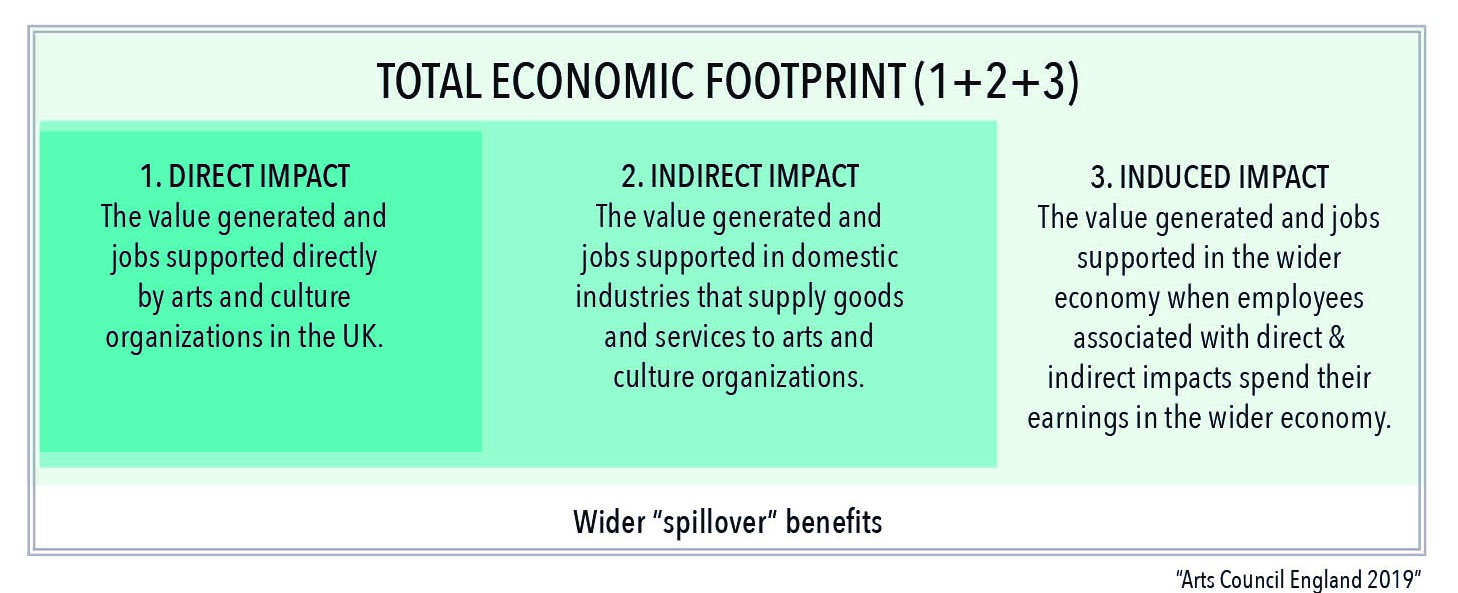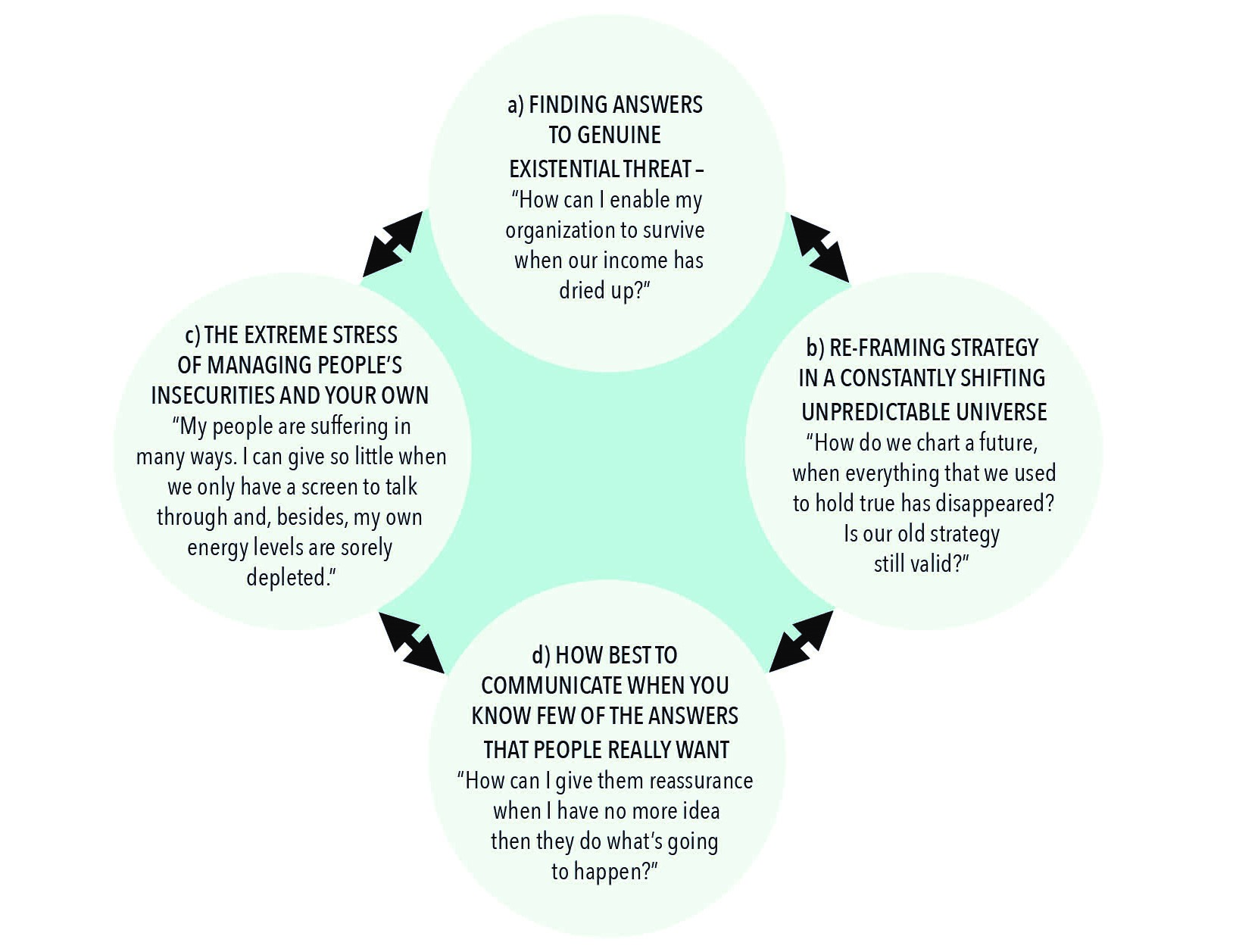
How to process feedback without getting defensive
You need feedback to fuel leadership growth, but it can feel hard and awkward to receive. Here are four essential tips to turn input into opportunities to learn and grow, without getting...

by Michael Day Published April 15, 2021 in Leadership • 10 min read
Leaders of arts and heritage organizations reveal the daunting challenges they have faced during the past year navigating closures and lockdowns
The cultural and creative industries are significant economic drivers in many countries. Cultural Times (UNESCO,2015) estimated their contribution to the worldwide economy at $250 billion in annual revenue, creating nearly 30 million jobs.
In the UK, the arts and culture industry (using estimates from Arts Council England 2019, based on a narrower definition than UNESCO’s) adds £10.8 billion ($15bn) annually to the UK economy. It generates £2.8 billion ($3.8bn) via taxation to the Treasury, and 363,700 jobs through a three-part total economic footprint of direct, indirect and induced impacts. It’s a model that would apply anywhere.

But it does so much more: how could we imagine the UK without the National Trust, the great palaces, museums and galleries, the theaters, opera, dance companies, concert halls, festivals, botanic gardens, castles, historic houses and ships, libraries and archives? These are places of learning and enjoyment, majesty and wonder, research and memory, creativity, excitement and social exchange, that are central to national identity: how we think about ourselves and how the rest of the world sees us.
This is not, of course, a uniquely British attribute – the same could be said of almost any country. All the major cities in the world have their own (often world-famous) museums, theaters, concert halls and historic buildings: Paris without the Louvre and Versailles? Washington without the Smithsonian museums? Sidney without the Opera House? Smaller states, regions, cities and towns everywhere have more local but nonetheless economically and culturally-important institutions.

In normal times, leading these cultural organizations has much in common with those in the for-profit or public sectors but with some notable differences. Typically in the UK and the US, these are non-profit organizations with boards of trustees, normally operating under charity, 501(c)(3) or similar legislation in the public interest. Around Europe and elsewhere, direct state or government operation is perhaps a more common model. But everywhere, they are values-driven with multiple bottom lines, of which financial performance is just one and fulfilling charitable or artistic purpose is the most important. They invariably have distinguished histories and are expected to exist forever. It’s assumed they simply cannot fail and be wound up.
Their size and complexity range from many thousands of employees to just a handful, as do their business models. Some generate all their own income from trading while others operate on a hybrid economy in which public funding plays a greater or lesser part. Most, if not all, are “volume-based cultural businesses operating on thin margins with limited reserves” (Stephen Feber 2021) and conform to Adrian Ellis’s characterization: “under capitalised, over extended organisations trying to balance the conflicting exigencies of mission and market.”’ (Arts Professional 2003).
In the spring of 2020, the COVID-19 pandemic struck arts, cultural and heritage organizations around the world, shutting most of them at a stroke and without warning. By June of last year in the US, 33% of responders in an American Alliance of Museums survey “were not confident they could survive sixteen months without additional financial relief and 16% felt their organisation was at significant risk of permanent closure”.
One year on, in March 2021, France 24 reported that “protesters were occupying three of the country’s four national theaters to demand an end to the closure of cultural venues imposed due to the pandemic as frustration grows with the months-long halt to performances. Theaters, cinemas, museums and other cultural spaces have been shut since France‘s last full lockdown in October and have remained closed despite most businesses reopening in December.”

The worldwide impact of all this has been felt directly, as Wikipedia tersely puts it, “by many individuals across the sector temporarily or permanently losing contracts or employment with varying degrees of warning and financial assistance available. Equally, financial stimulus from governments and charities for artists has provided greatly differing levels of support depending on the sector and the country.”
This unprecedented crisis has made huge demands on the leaders of cultural organizations. I asked these questions to some 30 senior leaders, mostly in the UK but also in the US and elsewhere in Europe, who were open and generous with their reflections.
1What were the most difficult challenges of leading through the last year?
2What were the important qualities that leaders showed to enable organizational survival?
3Has anything positive emerged from the turmoil?
In this article, I’ll look at their answers to the first question, while subsequent pieces will cover the other two. All quotes come directly from their confidential replies.
The hardest challenges fall into four interlinked main areas:

Existential threats
For organizations where self-generated income is the sole or main source, suddenly closing doors to paying audiences or visitors has required leaders to face “the existential question of survival”. “COVID has posed an existential threat to all I have achieved in 26 years at our museum,” reflected one CEO. Annual festivals have been especially hard hit: “The forced cancellation of our key annual event threatened the sustainability of the organization while we battled to secure the support that would allow us to continue to operate.”
While government furlough schemes and support grants have provided a vital lifeline, more needed to be done, in some cases: “pulling together a strong enough case to get a museum-saving loan from our bank” while others embarked on huge cost-cutting measures: “The financial impact on us has been considerable. As a result, we’ve been through a massive change programme – restructuring, losing more than 1,000 staff.”
The effect on theaters, with tightly-packed indoor spaces and productions needing a long lead-time, has been catastrophic. One CEO struggled with working out when to “reopen our doors to the million people that we usually welcome each year. Naively, our recovery plans were considering a summer 2020 re-launch. None of us expected theatres would be hibernating for over a year with the loss for us of 90% of our income.”
Re-framing strategy
Strategy is normally formed around a set of generally accepted assumptions, in a process that often takes months. Delivery stretches out over a longer period, needing just incremental adjustment as progress is achieved or the context changes. So what has been different?
“Although you could argue this entire year is unprecedented, its challenges are like many past experiences; it’s not the first time I have made big decisions swiftly or been presented with new information requiring a different course. However, the broader context has no set plan of action either. It feels like we are in onion layers of confusion and are all making it up as we go along. There’s no one thing to hang on to, no datum.”
Another CEO summed it up simply as “trying to maintain a long-term perspective in a constantly evolving situation – balancing the risk of getting things wrong because we were moving at such pace, with the need for fast decisive decision-making”. So, do established plans still hold good?
Alongside “trying to strike the right balance in dealing with the immediate problems of COVID while also looking to future opportunities”; another said: “There have been clear non-negotiable points on strategy, and our five-year plan has been stuck to, 70% achieved but in different ways. That’s important because it’s a drum beat of normality . . . steering a course despite the choppy waters, but accepting we are tacking a lot more than usual.”
Managing vulnerability
More replies fall into this area than any other – and often with heartfelt language, revealing the strain it has caused – “the sheer relentlessness of it”, said one. “COVID created huge insecurity. Overnight, everything changed; from an office base to homeworking, changes to terms of employment (everyone took a 20% pay reduction, some were furloughed), and the team had to accept that the festival we work towards all year wasn’t going to happen.”
Everyone has had their own set of personal challenges. “For some it was loneliness, for others it was anxiety about their own health or worries on behalf of loved ones. There was a big impact on colleagues with young families who struggled with home schooling. As leaders, we faced a number of serious challenges when staff voiced their unhappiness at decisions we made.”
For some leaders, it has exposed their own personal anxieties, demanding domestic and family arrangements, and loneliness. One graphically described “the absence of the nourishment that drives me in theater leadership: the moment where the show meets the audience. The electricity of 7.30pm and the fireworks that fall out when the show closes. Taking decisions in this void has been brutal . . . it’s 100% desk work for months on end.”

A museum CEO told me: “This has seemed much more difficult than normal – because of remote working and because of the ferocity of people’s emotions, together with their attribution of them to all the things they think you should fix, whilst not acknowledging that so much stems from the huge uncertainty, disruption and disappointment that has been unavoidable. You can’t always be reassuring – we have had to make very sad and difficult decisions.”
“What’s usually effortless is grinding and insensitive via Zoom. You can’t judge moods easily – it’s like leading in a straitjacket.”
And all this when the only channel for interacting with people has been Zoom or Teams. Another museum CEO described this challenge as: “Negotiating degrees of leadership presence – so much normally is about how you carry yourself and relate in person to others. What’s usually effortless is grinding and insensitive via Zoom, and some of my frontline people don’t even have laptops. You can’t judge moods easily – it’s like leading in a straitjacket.’
The personal cost to leaders has been severe: as one heritage COO told me: “At a personal level, this has really stretched my resilience – it has been a very long haul and I have had to pull on my support network and focus hard on staying physically well.”
Communicating when you don’t know the answers
This fourth set of reflections – about what and how to communicate – follow on from and connect with everything else. “Part of being a leader is to remove as much doubt and uncertainty as possible, so to portray a confidence and certainty which has been built on assumption rather than anything firmer has been challenging, ”said one heritage leader. A museum CEO felt torn: “You have to stay positive and in control yet be human and vulnerable; to try to create confidence while not having a clue what’s going on . . .”
This idea of balance between two conflicting demands comes up several times: “I said at the outset that we should not be pessimistic (as this might result in not seeing opportunities) nor optimistic (as this might result in missing problems), but that we should be realistic. However, realism for some is mightily depressing for others. I have tried to overcome this by mapping key projects/activities and events in the coming years as pegs in the ground to aim for and pointing out that we have overcome big challenges before. However, the feedback is both ‘thank you for being honest’ and‘ can we be less gloomy?’”
Is there a way through this? Another saw it as a “balance between projecting the kind of clarity and certainty people need, while being honest that in many cases we know as little as our teams. I think honesty and openness is integral to authentic leadership and I don’t believe in parent-child styles. But there’s a time when the team need you to go with a hunch and tell them what you think is going to happen, how you intend to make it work and then do your best to stick with it.”
Finally, layered through all this has been the impact of one particular event – the emergence in mid 2020 of the Black Lives Matter movement. Many cultural organizations internationally sought to engage with this positively – committing to reach more diverse audiences, to create more inclusive workforces and to promote different historical narratives for collections and buildings in their care. In certain cases for staff groups, some leaders did not respond radically enough: “concerns were raised by staff around organizational responses to the Black Lives Matter movement. They became very personally engaged and passionate . . . the language and behaviors of the social media world were imported to the workplace.”’
“You can’t always be reassuring – we have had to make very sad and difficult decisions.”
However, the generally constructive response displayed by cultural organizations was not universally welcomed. Some found themselves enmeshed in the so-called culture wars as they played out in various countries with politicians, commentators and the media taking up cudgels on both sides. For one CEO, this contributed to creating an additionally “febrile environment” in which to deal with the larger stresses of the pandemic: “The hardest bit has been finding ourselves at the heart of a political maelstrom. Dealing with the media coverage and consequent abuse has demanded a high level of resilience that has definitely faltered on occasions. ”Another concluded: “If I were writing a book on crisis management for institutions, I would make the point that when you are weakened [i.e.by the pandemic] is when you are most vulnerable to such events.”
So, cultural leaders have found themselves in the front line of the fight for survival and still much-needed as providing reference points for society. According to Mami Kataoka, Director of the Mori Art Museum, Tokyo (ICOM UK Museum News, August 2020): “Right now, amid the pandemic, many people are reflecting on the everyday, and on life and death. Essential and fundamental questions that are usually not thought about are simultaneously being examined. It is a very particular time, and the role that must be accomplished by the arts under such circumstances is not at all minor.”
The COVID pandemic has tested cultural organizations to breaking point. Never has good leadership been more needed. I have watched my sector colleagues deliver this in the face of the most testing challenges and have hugely admired their skill, courage and determination in steering their organizations through the storm. In the next article, I will reflect on the leadership qualities they say have been most valuable and in the final one, the unexpected positives that will help to frame a different, and hopefully brighter, future.

CEO of the United Kingdom’s Historic Royal Palaces from 2003 to 2017
Michael Day was CEO of the United Kingdom’s Historic Royal Palaces from 2003 to 2017, where he led an organizational transformation program at the Tower of London, Hampton Court Palace, and Kensington Palace. A trustee of the National Trust and Chair of The Royal Tennis Court, he has taught cultural leadership, governance and historic site interpretation around the world. He was awarded an Honorary Doctorate by Kingston University in 2010, and appointed Commander of the Royal Victorian Order in 2015.

December 17, 2025 • by Winter Nie in Leadership
You need feedback to fuel leadership growth, but it can feel hard and awkward to receive. Here are four essential tips to turn input into opportunities to learn and grow, without getting...

December 15, 2025 • by Jean-François Manzoni in Leadership
What does it take to lead a global enterprise today? Six CEOs outline the behaviors that have helped them excel in their roles, from disciplined delegation and elevating perspective to mastering self-reflection...

December 11, 2025 • by Charlotte Søby Vestergaard in Leadership
Sanofi’s Global Head of Digital Markets, Charlotte Vestergaard, on the courage and connections, discipline and passion it takes to pursue a non-linear leadership career, and how her passion for pharma sits at...

December 8, 2025 • by Anna Erat in Leadership
As lifespans increase and the world’s population gets older, organizations must rethink leadership, career design, and workforce strategy, says Anna Erat. ...
Explore first person business intelligence from top minds curated for a global executive audience